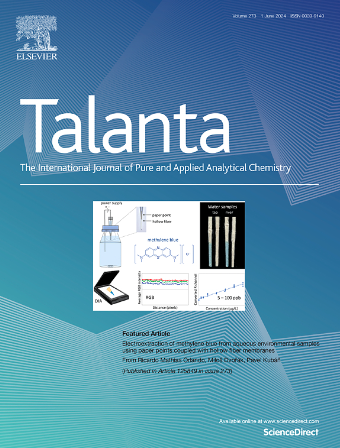Dual enzyme-mimicking bimetallic MOF for selective SERS detection of L-DOPA in human serum based on cascade catalytic reaction
IF 5.6
1区 化学
Q1 CHEMISTRY, ANALYTICAL
引用次数: 0
Abstract
Surface-enhanced Raman scattering (SERS) in conjunction with nanozymes has emerged as a powerful technique for bioanalysis due to their signal conversion and amplification effect. However, clinical applications continue to encounter challenges such as inadequate selectivity. Herein, we proposed a novel approach for the selective SERS detection of L-DOPA in human serum with dual enzyme-mimicking MOF-919(Fe–Cu). This material exhibits both catechol oxidase-like and peroxidase-like activities, enabling it to catalyze catecholic compounds to o-quinones and subsequently oxidize 3,3′,5,5′-tetramethylbenzidine (TMB) molecules into SERS-active ox-TMB. Ultrasonic-assisted synthesis ensures uniform and dense loading of AgNPs within MOF-919(Fe–Cu), thereby enhancing SERS activity. A sensitive and selective method for SERS detection of L-DOPA was developed. The catechol oxidase-like activity of MOF-919(Fe–Cu) provides ideal selectivity and anti-interference to L-DOPA, while the cascade catalytic system transforms weak SERS signals of L-DOPA into amplified SERS signals of ox-TMB. The mechanism of dual enzyme-mimicking activity was further discussed. The detection process was optimized to achieve high sensitivity towards L-DOPA with a linear range 0.5–100 μmol/L and low limit of detection (LOD) of 0.16 μmol/L. Furthermore, it has been applied in serum sample of Parkinson's patients, demonstrating excellent recovery and low relative error compared to HPLC-UV. This approach offers an economical, efficient and accurate strategy for the detection of L-DOPA and provides valuable insights for the integration of selective multifunctional nanozyme and sensitive SERS detection method.

基于级联催化反应的双酶模拟双金属MOF对人血清中左旋多巴的选择性SERS检测
表面增强拉曼散射(SERS)与纳米酶结合,由于其信号转换和放大效应,已成为一种强大的生物分析技术。然而,临床应用仍面临选择性不足等挑战。本文提出了一种利用双酶模拟MOF-919(Fe-Cu)选择性SERS检测人血清中L-DOPA的新方法。该材料具有儿茶酚类氧化酶和过氧化物酶类活性,使其能够催化儿茶酚类化合物生成邻醌,随后将3,3 ',5,5 ' -四甲基联苯胺(TMB)分子氧化为具有sers活性的氧-TMB。超声辅助合成确保了MOF-919(Fe-Cu)内AgNPs的均匀和密集加载,从而增强了SERS活性。建立了一种灵敏、选择性强的左旋多巴SERS检测方法。MOF-919(Fe-Cu)的儿茶酚氧化酶样活性对L-DOPA提供了理想的选择性和抗干扰性,而级联催化系统将L-DOPA的弱SERS信号转化为x- tmb的放大SERS信号。进一步探讨了双酶模拟活性的机理。优化检测工艺,对L- dopa具有较高的灵敏度,线性范围为0.5 ~ 100 μmol/L,低检出限为0.16 μmol/L。此外,它已应用于帕金森患者的血清样本,与HPLC-UV相比,具有良好的回收率和低的相对误差。该方法为L-DOPA的检测提供了一种经济、高效、准确的方法,为选择性多功能纳米酶与灵敏SERS检测方法的整合提供了有价值的见解。
本文章由计算机程序翻译,如有差异,请以英文原文为准。
求助全文
约1分钟内获得全文
求助全文
来源期刊

Talanta
化学-分析化学
CiteScore
12.30
自引率
4.90%
发文量
861
审稿时长
29 days
期刊介绍:
Talanta provides a forum for the publication of original research papers, short communications, and critical reviews in all branches of pure and applied analytical chemistry. Papers are evaluated based on established guidelines, including the fundamental nature of the study, scientific novelty, substantial improvement or advantage over existing technology or methods, and demonstrated analytical applicability. Original research papers on fundamental studies, and on novel sensor and instrumentation developments, are encouraged. Novel or improved applications in areas such as clinical and biological chemistry, environmental analysis, geochemistry, materials science and engineering, and analytical platforms for omics development are welcome.
Analytical performance of methods should be determined, including interference and matrix effects, and methods should be validated by comparison with a standard method, or analysis of a certified reference material. Simple spiking recoveries may not be sufficient. The developed method should especially comprise information on selectivity, sensitivity, detection limits, accuracy, and reliability. However, applying official validation or robustness studies to a routine method or technique does not necessarily constitute novelty. Proper statistical treatment of the data should be provided. Relevant literature should be cited, including related publications by the authors, and authors should discuss how their proposed methodology compares with previously reported methods.
 求助内容:
求助内容: 应助结果提醒方式:
应助结果提醒方式:


